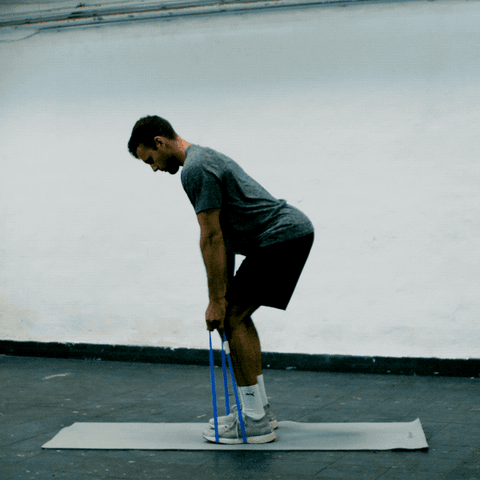3 Resistance Band Exercises for Bigger Biceps

In the old days, before advances in sports science and physiotherapy, the belief went that in order to build muscle and strengthen your biceps, you’d need to pick up some dumbbells.
Not any more. Resistance bands are just as good as free weights or gym equipment when it comes to strength training. [1] Not only that, resistance bands can be a great option to switch to if you're tired of going to crowded, over-priced gyms or simply can't go – thanks to the pandemic.
Why are resistance bands better than free weights?
Training with a resistance band can be unfamiliar territory for many people, and some even avoid it because of uncertainty about how to use them.
The essential thing is: a resistance band lets you perform the same exercises that you’re used to with gym machinery or free weights. Not only that, an intelligent resistance band can be even better than free weights when training your biceps. Personal trainer and dietician Luke Zocchi summarised it thus:
"Like dumbbells, resistance bands provide a level of resistance to help your muscles tear and become stronger. However, unlike dumbbells, resistance bands maintain constant tension on the muscles throughout the entire movement of an exercise, and therefore create greater muscle growth." [2]

Meanwhile, noted trainer and fitness guru Jeff Cavaliere states:
“The dumbbell curl places the most tension on the biceps in the middle range of elbow flexion, when gravity is most perpendicular to the moving limb. The banded curl places the most tension in the upper third of the range, when the band is most stretched.[3]
In addition to standard training, resistance band workouts can also improve your exercise technique and form. As Juliet Kaska, a celebrity health and fitness expert and member of the Vionic Innovation Lab, put it:
“Resistance bands require you to work both the eccentric and concentric contractions… The concentric contraction is the shortening of the muscle (what most people think is the actual exercise). For example, if you're doing a bicep curl, this is the portion where you bring the weight up, shortening the space at the elbow. The eccentric contraction is when you bring the weight down. It's this eccentric movement that most often gets neglected when doing exercises with free weights, leading someone to drop the weight rather than slowly bring it down with resistance. By using a resistance band, you're less likely to cheat yourself out of half an exercise, keeping your muscles engaged throughout.” [4]

3 resistance band exercises for building biceps
This short workout is designed to target your biceps with several exercises. The standing row exercise also engages your back and core muscles to mix things up a bit.
1. Biceps Curls
Stand on the resistance band with your feet shoulder width apart. Hold the band in both hands on each side of your body.
Pull the band upwards, bringing your fists towards your chest. Move your arm back down in a controlled movement.
Pro tip: Keep your elbows close to your body. Hold your upper body stable and your core engaged.
Level: Easy

The Biceps Curls exercise in action
2. Standing Row
Place your feet at shoulder width. Bend forward.
Hold the elastic band on each side of your body with our palms facing towards your body.
Knees are slightly bent, back stays straight. Initiate movement with your shoulder blades. Lift your elbows up and pull the band towards your belly button.
Pro tip: Keep your chin up. Initiate movement with your shoulder blades. Squeeze shoulder blades at top position.
Level: Medium

The Standing Row exercise in action
3. Single Biceps Curls
Stand on the band with one foot. Grip the band in one hand. Apply tension in lower position.
Pull the band and bend your arm until your hand is at chest height. Move your arm back down in a controlled movement.
Pro tip: Elbows stationary. Stay straight.
Level: Easy

The Single Biceps Curls exercise in action
How many reps?
20 reps of bicep curls, 20 reps of standing row and 20 reps of single biceps curls left and right. Repeat the whole exercise 2 times.
Area of Focus: Biceps.
Let’s be real though: traditional bands have their own shortcomings. They lack tracking and monitoring of your progress. You can only estimate how much weight you are using and that makes it hard to gauge the effectiveness of your workouts.
Enter STRAFFR, the intelligent resistance band
Whichever body area you want to target or improve, STRAFFR is here to achieve your individual fitness goals.
The connected Fitness Platform guides, evaluates and records your progress throughout and after your session.
Following fitness analysis, the STRAFFR app configures the best training plan for your fitness level. It’s a personalized experience, allowing smart technology to follow your lead and guide you when necessary.

As your fitness and ability improve, it’s easy to increase the resistance level by changing your grip and, the app will follow. You’re walking around with an infinite number of free weights in your pocket.
With more than 50 exercises, STRAFFR provides you with real-time feedback. It’s your new personal trainer. Only less annoying.
Whether you are a beginner or a pro at working out your arms, STRAFFR lets you perform the same exercises at a variety of custom intensity levels.
You can even customize your own training plan and choose your preferred exercises.
Thanks for reading! To find out more about STRAFFR, the intelligent resistance band, head over to the website and pick one up for yourself.
[1] A Comparison of Elastic Tubing and Isotonic Resistance Exercises
[2] Resistance bands are more portable and versatile than dumbbells
[3] Trainer and fitness guru Jeff Cavaliere
[4] Why Resistance Bands Are as Good as Free Weights, According to a Trainer

